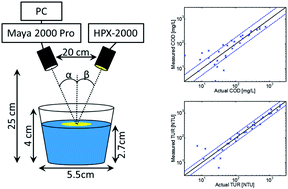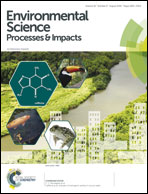Non-contact assessment of COD and turbidity concentrations in water using diffuse reflectance UV-Vis spectroscopy
Abstract
Water contamination is an important environmental concern underlining the need for reliable real-time information on contaminant concentrations in natural waters. Here, a new non-contact UV-Vis spectroscopic approach for monitoring contaminants in water, and especially wastewater, is proposed. Diffuse reflectance UV-Vis spectroscopy was applied to measure simultaneously the chemical oxygen demand (COD) and turbidity (TUR) concentrations in water. The measurements were carried out in the wavelength range from 200–1100 nm. The measured spectra were analysed using partial-least-squares (PLS) regression. The correlation coefficient between the measured and the reference concentrations of COD and TUR in the water samples were R2 = 0.85 and 0.96, respectively. These results highlight the potential of non-contact UV-Vis spectroscopy for the assessment of water contamination. A system built on the concept would be able to monitor wastewater pollution continuously, without the need for laborious sample collection and subsequent laboratory analysis. Furthermore, since no parts of the system are in contact with the wastewater stream the need for maintenance is minimised.


 Please wait while we load your content...
Please wait while we load your content...